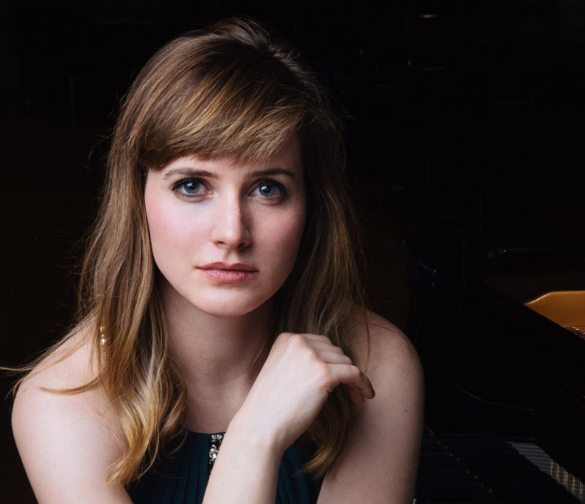Amy E. Gustafson in Review
Amy E. Gustafson, pianist
Florence Gould Hall, French Institute, Alliance Française, New York, NY
June 9, 2017
A sizable crowd at Florence Gould Hall was treated on June 9th to an evening of Debussy played by pianist Amy E. Gustafson to mark the release of her new CD entitled Reverie. The CD includes Book II of the Préludes, Suite Bergamasque, L’Isle Joyeuse, and the title piece, Reverie. The recital program included nearly all of the works from the CD, with the exception of three of the Préludes (Les fées sont d’esquises danseuses, La terrasse des audiences du clair de lune, and Les tierces alternées), and with the Reverie not listed but being added as an encore. It was a beautifully crafted program showing Ms. Gustafson to be a sincere artist with a deep commitment to this repertoire.
It is not easy to pull off an entire recital of Debussy, but Ms. Gustafson did just that, and not once did the music overstay its welcome. She is not a performer of overt drama or physical demonstrativeness, but if one listened rather than watching (the point, after all), one found her to have ample emotional range within a carefully defined tonal palette, along with a keen sense of shape and direction within that palette. She tended to avoid dynamic extremes and the flood of pedal in which many indulge, opting for a more “pen-and-ink” approach to Debussy’s fine details, and it was a delight to hear.
Where Debussy required, Ms. Gustafson showed a versatile sense of his more theatrical characterizations, conveying the bumptious pace of Général Lavine – eccentric, the whiff of Dickensian air in Hommage á S. Pickwick, Esq. P. P. M. P. C., and the sinister shimmer of the nymph Ondine (painted with far fewer brushstrokes than Ravel’s Ondine, but with a similar spirit).
At the same time, Ms. Gustafson was unafraid of the grays of Brouillards (Fog), the subtle shades in Feuilles mortes (Dead Leaves), and the deathly stillness of Canope (Canopic Jar – the jar used for various remains of mummies). These three pieces combined could represent the kiss of death in a live recital, given the ever-decreasing attention spans of many audiences today, but this pianist credited her listeners with keen sensibilities, and she was rewarded with the same. She led her willing listeners on a journey of the imagination, and for that she won my complete admiration. The touching simplicity of Bruyères (Heather) was captured perfectly as well.
The brighter musical colors of La Puerta del Vino and Feux d’artifice (Fireworks) were welcome, but Ms. Gustafson was never bombastic, and she never overplayed. I might have even wanted a touch more fire in the “fireworks” – but this is again individual. Vive la différence!
Taking no intermission (another plus in my opinion), Ms. Gustafson followed the Préludes with the Suite Bergamasque. It was refreshing to hear this four-piece set in its entirety, as one so often hears selections from it, particularly the Clair de Lune and to a lesser extent the Passepied. One can always safely bet that heads will turn as the dreamy Clair de Lune opens, listeners looking towards another as if to say, “that’s our song” or “remember this, my favorite?” – and I won that bet again. By virtue of such familiarity, performing the piece can be somewhat daunting; Ms. Gustafson knew what she was doing, however, and she played it beautifully with only the tiniest of glitches. Notable was how she took time to let the music speak. The musical result was richly satisfying. The Minuet from the same suite did not fare quite as well, with a few lapses along its winding path, but the Passepied concluded the set beautifully. Throughout the recital, Ms. Gustafson had shown thorough attention to detail, including some expert pedaling (for example in Ondine), but her delicate approach was especially impressive in the Passepied.
L’Isle Joyeuse capped off the program with joy, even if occasionally this listener wanted more abandon. The beginning was a bit measured sounding and even the end, not quite as ecstatic as I’ve heard – but again, these matters are highly individual. (This listener also wanted to hear more of the crests and nadirs in each wave and perhaps a bit less of the textures in between).
All in all, these tonal scenes and vignettes seemed the perfect musical fare for Florence Gould Hall, a venue frequently used for cinematic arts, particularly French films. In lieu of subtitles, we had some very expressive and articulate program notes by the pianist. She clearly wanted to share her reactions to this music, and she did so in every possible way. It was a wonderful evening.
Without a doubt, the high point of the recital for this reviewer was the encore, Reverie. In a slower–than-usual tempo, Ms. Gustafson savored each moment of the daydream. It was truly moving, and I’d have to place it high on the list of my favorite renditions of this piece. If you’d like to hear it, you can hear something close to it (without the live performance magic but still beautiful) on her CD (visit http://www.amygustafson.com).

